Send Enquiry & Get Itinerary on Whats App
Everest Base Camp
- Kathmandu to Kathmandu
- Book Now at Just ₹ 20000
- We are the largest Service providers in India. i.e No outsourcing
- Most Reliable Trekking Community in India
- Highest Rated Trekking Company in India
- Highly Trusted Trek Operators For Nepal
- Certified by Startup India, Uttarakhand Tourism, MSME and STU
- Top 10 Most Promising Adventure Travel Company in India
Call our Everest Base Camp Trek Expert Mr. Aman to know more about the trek
Trek Duration
14 Days
Trek Distance
110 Km.
Difficulty Level
Difficult
Altitude
18200 Ft.
Best Season
Mar-May to Sept- Nov
Trek Fees
₹ 55000 ₹49999
Kathmandu to Kathmandu
Call our Everest Base Camp Expert Mr. Aman to know more about the trek
ADD ONS
- Airport Pick and Drop to hotel ₹ 2400/person
INCLUSIONS
- Transportation from Joshimath to Govindghat and back
- Meals - (Veg Only- Breakfast, Lunch, Evening Snacks and Dinner)
- Accommodation in Hotel in Joshimath/Ghangharia
- Experienced Trek Leader, Professional Guides and a very supportive staff
- Forest permits
- Medical Amenities – First Aid Kits, Oxymeters, oxygen cylinders.
- Sanitised and Hygienic Camp sites and Hotels
EXCLUSIONS
- Anything not mentioned in inclusion list
- Meals during Transportation
- Any kind of personal Expenses
- Unscheduled or extended stay due to road blocks, Landslides
- Porter/mule charges (Personal), Back pack offloading Charges
- Cost of Evacuation in case of emergency
MODE OF TRANSPORTATION
- No of Persons (1-4) : Swift/Zest or Equivalent Vehicle
- No of Persons (5-7) : Tata Sumo/Mahindra Bolero or Equivalent Vehicle
- No of Persons (8-13): Tempo Traveler
CALENDAR
- June: Everyday departure after 20 June
- July: Every Day Departure
-
Aug: Every Day Departure
- Sept: Everyday Departure till 15th of the month
- In case you want to Customize a trek for your group. Give us a call at 8979920602/8006074398
ADD ONS
- Airport pick up and Drop ₹ 2400/person
SUMMARY KASHMIR GREAT LAKES
| Country | Nepal |
| Difficulty Level | Difficult |
| Duration | 14 Days |
| Start Point | Kathmandu |
| End Point | Kathmandu |
| Altitude |  18200 ft 18200 ft |
Ready for Adventure? Rent Your Trek Gear Today
INCLUSIONS
- Airport pick up and drop for international terminal.
- Kathmandu domestic airport transfers for Lukla flights.
- Accommodation in Hotel in Joshimath/Ghangharia on Triple/Quad Sharing Basis
- Accommodation in Kathmandu on twin share basis (2 nights).
- Accommodation during the trekking period, in local mountain lodges called Tea House on twin share basis.
- Domestic return flight tickets (Kathmandu - Lukla – Kathmandu, or Ramechhap – Lukla-Ramechhap).
- Shared transport for Ramechhap, both sides (if Lukla flight operational from Ramechhap).
- All necessary paperwork and trekking permits (National Park Permit, Khumbu Permit).
- Certified guide.
- Assistant guide (for 5 or more people).
- Porter service
- Medical kit (carried by your trek leader).
- All government and local taxes.
- Please Note: For single trekker we provide porter cum guide.
EXCLUSIONS
- Travel expenses to reach and return from Kathmandu.
- Food and drinking water throughout the trip.
- Anything not specifically mentioned under inclusions section.
- Cancellation, health, or any other reason.
- Personal expenses (phone calls, laundry, bar bills, battery recharge, extra porters, bottle or boiled water, shower, etc.).
- Health Insurance, Personal Insurance, and other travel insurance.
- Expenses for evacuation and rescue operations due to natural calamity, mishaps, injury, or any health problem.
- Nepalese visa fee (if applicable).
- Tips for guide(s), porter(s).
MODE OF TRANSPORTATION
- No of Persons (1-4) : Swift/Zest or Equivalent Vehicle
- No of Persons (5-7) : Tata Sumo/Mahindra Bolero or Equivalent Vehicle
- No of Persons (8-13): Tempo Traveler
- Selection of vehicle depends on availability. In group departures vehicles are Non AC
2700+ Five Star Google Reviews For TSS







Everest Base Camp Trek Overview & Itinerary
The Everest Base Camp (EBC) trek stands out as one of the most iconic and thrilling adventures globally, located at an altitude of 5,364 meters in Nepal’s Khumbu region. It is a 14 Day Trek that starts and ends at the Kathmandu Town of Nepal. It is known for its stunning landscapes, rich Sherpa culture, and the immense satisfaction you get after reaching the base of the Mount Everest.
Everest Base Camp is renowned for its diverse flora which includes rhododendrons, blue poppies, and birches. The fauna includes the Himalayan tahr, snow leopard, musk deer, red panda, and Himalayan monal. This trek is part of the Sagarmatha National Park, which features rugged terrains, glaciers, and deep valleys, which offer a diverse and unforgettable trekking experience.
The trek to Everest Base Camp winds through dense forests and crosses the Dudh Koshi River multiple times. Trekkers encounter numerous suspension bridges, waterfalls, and Sherpa villages. The ideal times to visit Everest Base Camp are from March to May and September to November. These time periods are known for their stunning mountain views and rich cultural experiences. The trail showcases around 1,500 plant species and numerous animal species.
The beauty of the trek cannot be fully captured by camera, one must experience it in person. It is one of the most favorite destinations for trekkers, adventure seekers, photographers, nature lovers, and wildlife enthusiasts.
The Everest Base Camp trek offers a dynamic journey that changes with the seasons, providing unique experiences from March to November. This tourist attraction is famous among both Nepalese and International visitors. Every year, thousands of foreigners visit to witness the awe-inspiring beauty of the Himalayas.
Another highlight of this region is Kala Patthar, known for offering the best views of Mount Everest. Situated at an altitude of 5,545 meters, it provides a panoramic view of Everest, Lhotse, and Nuptse Peaks. This is the most difficult as well as the most rewarding part of your whole trek.
Namche Bazaar is a vibrant Sherpa town that serves as the gateway to the high Himalayas. Trekkers stay here to acclimatize during the trek to Everest Base Camp. It is a crucial stop that helps prepare trekkers for the higher altitudes ahead. Book your Everest Base Camp Trekking Package today.
What is special about Everest Base Camp trekking packages ?
● Trek to an altitude of 5,364 meters, which provides a thrilling adventure for
high-altitude enthusiasts.
● Spectacular views of Mount Everest and some of the tallest Himalayan Peaks such
as Makalu, Amadablam, Lhotse, Nuptse .
● UNESCO World Heritage site (Sagarmatha National Park).
● Rich Sherpa culture and ancient monasteries.
● Experience the exhilarating flight to Lukla, one of the world’s most exciting airports.
● A trek that offers varied landscapes from lush forests to high-altitude terrains.
● Best Time to Visit – April (Spring) and October (Autumn) for clear skies and stable
weather.
● Opportunity to visit the vibrant Sherpa town of Namche Bazaar.
● Reach Kala Patthar for the best panoramic views of Everest, making it a highlight of
the trek.
● Encounter unique Himalayan wildlife and over 1,500 species of plants within
Sagarmatha National Park.
Ready for Adventure? Rent Your Trek Gear Today
Why you Should Choose TSS : The Most Reliable Trekking Company in India
EVEREST BASE CAMP TREK ITINERARY
- Pickup from Airport and drop in Hotel.
- Enjoy your time in Thamel Street.
- One Can Visit Pashupatinath temple in the afternoon or can also visit various Casions at Kahtmandu.
- Overnight Stay at Kathmandu

- After breakfast we will proceed to the Tribhuvan Domestic Airport, Kathmandu.
(Please Note: Sometimes flight to Lukla for Kathmandu gets cancelled so we need to board the flight to Ramechhap. Ramechhap is around 140km from Kathmandu.)
- Flying time to Lukla is 35 mins.)
- The flight will be passing through valleys and presenting some breathtaking view of the mountain ranges and the Nepali villages stop.
- Once we arrive in Lukla, immediately we will start our trek to Phakding.
- Trek to Phakding in as easy descend of 8km
- Overnight stay at the Phakding.


- Trek to namche Bazar is of Easy to Moderate Range.
- The DudhKoshiriver flows along the side till Namche.
- Get your lunch at Monjo
- You will be able to get a glimpse of Everest and Lhotse just before Namche.
- Namche is the last point where you will get mobile Network.
- Overnight stay at the Namche Bazaar at Tea House.

- Today we visit the Namche Museum which is extremely popular for it’s newly built statue of Tenzing Norgay.
- After the museum we will do a short hike to Syangboche Airport then follow a trail towards Khumjung Village.
- The view from Syangboche is very spectacular as you can see a magnificent view of Everest, Lhotse and Amadablam
- Staying at Khumjung village helps our body to acclimatize better for the further duration of the trek.
- Khumjung is a big village situated at the foothill of scared mountain Khumbila, in the 1970’s mythical creature Yati spotted in the same village.
- Overnight stay at the Khumjunga in Tea House



- Trek during this day is of moderate difficulty
- The Tengboche Monastery is a famous and beautiful place, worth visiting.
- Overnight stay at the Tengboche in Tea House.

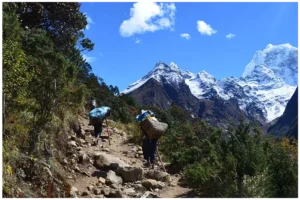
- Trek during this day is of moderate difficulty as we enter the upper Himalayas region
- Today we will start the trek towards the Pangboche village, get some views of Mount AmaDablam.
- Have our lunch at Shomare Village which is the last village before Dingboche.
- Then trek towards Pheriche and proceed to the Imja Valley.
- Enjoy the view of Lobuche river and will pass through it and take moderate hike to Dingboche
- Overnight stay at Dingboche in Tea House.


- Today will be an acclimatization day.
- Take a small hike to get a view of worlds two top mountain peaks, Mount Lhotse the 4th highest and Mount Makalu the 5th
- Overnight stay at Tea House.

- Trek during this day is of moderate to difficult grade
- Today we will start the trek towards Dughla and the Lobuche.
- On this route we see a huge stream and many mountains peaks including Mount Pumori (7138m), Mount Nuptse, Mount Cholatse and Mount Thamserku.
- Once we pass the Khumbu Glacier, we will see the highest peaks such as Khumbutse, Lingtren, Pumori and Mahalangur.
- Overnight stay at Lobuche.



- The trek to Gorakshep and Everest Base Camp is likely to be moderate to difficult trek.
- You can see the Everest on the way, but you cannot get a full view from Base Camp, the Khumbu icefall will be very clearly visible.
- This part of the trek will surely feel like you are in heaven amidst the glaciers and see the gigantic mountain up-close.
- Overnight stay in Gorakshep in a tea house.

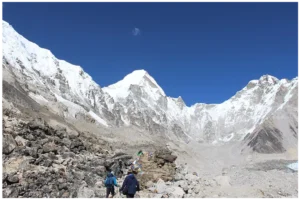
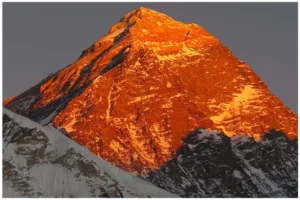


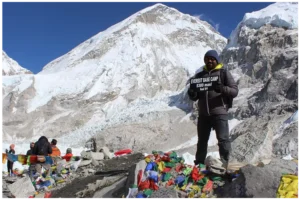
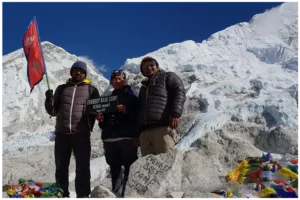

- Hike to Kalapathar is of Moderate Difficulty. High altitude Climb sometimes makes it difficult for trekkers to climb to Kala Patthar. Trek to Kala Patthar is approx 4km
- From Kala Patthar you can have clear glimpse of Everest.
- Kala Patthar is the only place which will give you views of almost the entire high peak mountains of the nearby Himalayan Range.
- Trek Down to Pheriche a gradual descend of 9km.
- Overnight stay at Pheriche




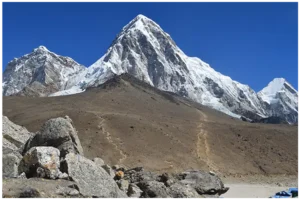
- CrossTengboche on your way to Namche Bazaar.
- After PhungiThanka it is a small uphill hike for a short distance then the trail become flat till NamcheBazzar.
- Overnight stay in a tea house.

- This will be a simple trek
- Get a small incline just before Lukla
- Overnight stay at Lukla in a tea house.

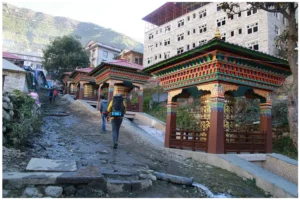

- Proceed to the Airport and catch our flight to Kathmandu.
- Overnight stay at Hotel.

- Check out by 11 am to catch your flight.

Delighted #TSSTrekkers
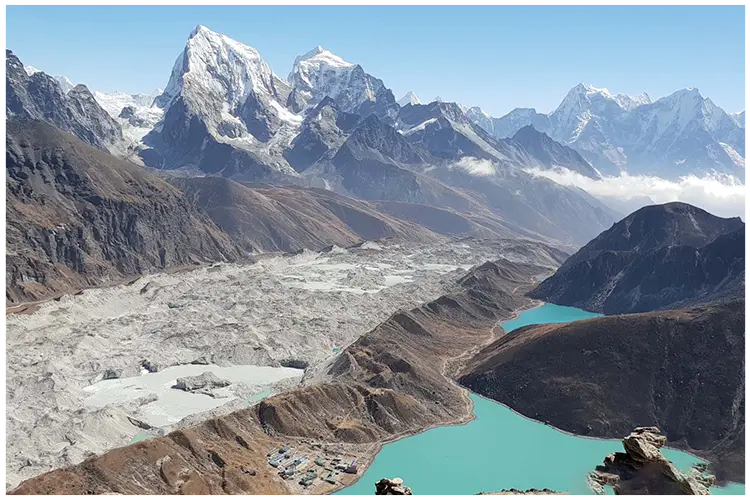
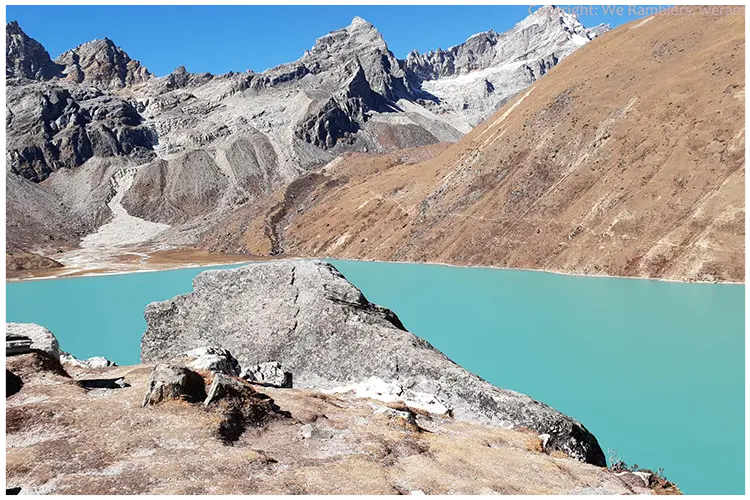



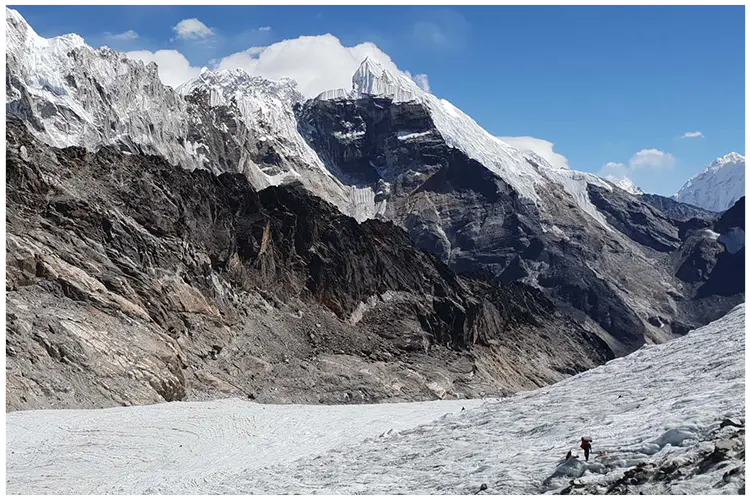












Trek Essentials
TSS Jumbo Bag
- Backpack/Ruck Sack (at least 55 Litres) and a small day bag ( upto 15 litres) for summit day
- Poncho/Raincoat and Rain Cover for Ruck Sack
- 2 Quick Dry T-shirts (preferably Full Sleeves) and Track Pants
- Warm Jacket preferably a down jacket or an equivalent heavy jacket to protect from cold at night
- Comfortable Shoes with a good grip and ankle support. We recommend Quechua Forclaz 100 or similar shoe
- A pair of fleece jacket or fleece upper
- Good Thermals for insulation at night
- Lip Balm and Cold Cream
- Sun Cap or Sunscreen (SPF 30+)
- Dark Sunglasses. People who wear spectacle may use photochromatic lenses in their spects
- 2 pair of warm socks and at least 2 pair of normal cotton socks
- 1 Pair of slippers/Sandals
- Woolen Cap and Gloves for night
- Toiletries – Tooth brush, Tooth paste, Liquid soap, Hand Sanitizers, Slippers, Light Towel, Toilet Roll (Avoid wet tissues as they are not eco friendly)
- Torch or Headlamp with extra pair of batteries
- Personal Medical Kit: Crocin-Fever, Avomine-Motion Sickness, Avil 25mg – Allergies, Combiflam, Disprin-headache, Norflox TZ & Lomofen-diarrhea, digene-acidity, omez/rantadine antacid, crepe bandages, band aids, ORS, betadiene or antiseptic cream, moov spray/volini, cotton, gauze.
- Water bottle 1 L or Hydration bag 2 L
- Other personal accessories – Camera, Tripod, mobile charger, power banks(as there will be no electricity during the trek)
Note:
- Note: AC doesnt run on hills in fixed departure batches. Standard Non AC vehicles are provided for transportation
- Being a high altitude trek, this trek is suitable for climbers with good physical condition and stamina.
- This is a tentative itinerary which may change as per weather conditions
- We expect you to carry your rucksacks, in case if you want them to be carried by mules back pack offloading charge up to Rs. 300/bag/day is applicable
- In case of any natural calamity the company will not be able to refund the trip charges, for more details check our cancellation policy
FAQs
A: Yes, it is highly recommended to have travel insurance that covers high-altitude trekking, medical emergencies, and evacuation. Make sure your policy covers the maximum altitude you will be reaching.
A: The best time to visit Everest Base Camp is Spring (April) and Autumn (October). During these months, the weather is relatively stable, and the views of the mountains are clear, offering the best trekking experience.
A: The Everest Base Camp Trek is a Difficult grade Trek. However, with proper acclimatization and physical preparation, it is achievable for many trekkers, including those with moderate fitness levels.
A: The Trek is 13 Km from the nearest road head Poolna and is broken in 2 parts. Part 1 Poolna to Ghangharia, Part 2 Ghangharia to Valley of Flowers. It requires atleast 5 days from nearest Railway station – Haridwar.
A: The trek offers a unique combination of breathtaking landscapes, rich Sherpa culture, and the thrill of reaching the base of the world’s highest mountain. It also passes through Sagarmatha National Park, a UNESCO World Heritage Site, home to diverse flora and fauna.
A: The trek to Everest Base Camp is approximately 110 km (round trip) and typically takes 14 days to complete, including acclimatization days to help prevent altitude sickness
A: We wouldn’t recommend The Everest Base Camp Trek for beginners as it is considered challenging due to the high altitude and long duration. While beginners can undertake the trek, it requires good physical preparation and awareness of the challenges posed by high altitude. Guided tours with acclimatization schedules are recommended for first-time trekkers.
A: Mobile signal is available in some parts of the trek, particularly in larger villages like Namche Bazaar. However, connectivity can be sporadic, and it’s advisable to be prepared for limited communication.
A: You will need to carry personal gear, including suitable clothing, trekking boots, and a daypack. We provide a porter in our package to carry your luggage as it would be difficult to carry your luggage and do the trek because of high altitude. However, if you are comfortable in carrying your own luggage you can do that as well.
A: Guides are trained in first aid and can handle most basic health issues. In case of severe altitude sickness or other emergencies, trekkers are evacuated to lower altitudes and taken to the nearest medical facility. Helicopter Evacuation is also available.
A: Wi-Fi is available at some teahouses and lodges along the trail, but it is often limited and can be expensive. Free Wi-Fi is rare, with some exceptions like Starbucks in Lukla and Everest Bakery in Namche Bazaar.
A: Preparation should start several months in advance and include cardiovascular training (running, cycling), strength training, and hiking with a weighted backpack. This helps build the endurance needed for long trekking days and high altitudes.
A: Accommodation along the Everest Base Camp trek typically includes tea houses or lodges. These provide basic facilities, including a bed, blanket, and shared bathroom.
A: To prevent altitude sickness, acclimatize properly by taking rest days, hydrating well, and ascending slowly. Symptoms include headaches, nausea, and dizziness. If symptoms worsen, descending to a lower altitude is crucial.
You can keep extra luggage in the base village for any particular trek. There are no cloak roo charges applicable. Its free of cost
If you are going on a trek don’t expect mobile signals. There are few spots on the trails of few treks where you might find a single tower or something but it always depends if that is enough to make a call or not.
Yes, TSS team can organize private batches for individual groups, but the cost of the trek may vary according to the number of members in your group. You can talk to our trek coordinator via whatsapp/call to get the customized group rates.
It’s a strict no. If you fall sick during the trek due to alcohol consumption TheSearchingSouls has the right to cancel your trek and send you back to base village. No expenses shall be refunded in that case and you will have to pay additional for stay at base village.
Start running/walking at least 3-4 Kms everyday.
If it’s a snow trek a good trekking shoe is mandatory. If you buy a new shoe do walk for few days so that it fits you well and doesn’t leave you with blisters while you trek. If it is a summer trek or post monsoon trek a shoe with good grip and ankle support will do.
We provide 3 Veg meals and evening Snacks. There will be no non veg served during the trek. Eggs may or may not be served depending on the trek.
We will provide sleeping bags, inner liners,
sleeping mats, tents. You just need to carry
your personal gear.
List of personal Gear is in our website
under Trek Essentials.
Himalaya Journeys Treks &Expedition prides itself on being prepared for any emergency situation. Our guides are trained in first aid and can deal with most of the basic ailments that occur during a trek. Every camp site has basic first aid and oxygen cylinders But if a serious emergency occurs, we will evacuate you to the base village and nearest hospital but the expenses of that has to be borne by the individual
How to Reach Kathmandu from India by Air, Road, and Rail
Reaching Kathmandu, Nepal from India can be done by air, road, and partially by rail. Here
are the detailed options for each mode of transportation:
By Air
Flying to Kathmandu is the most hassle-free and efficient way to travel from India. Tribhuvan
International Airport (TIA) in Kathmandu is well-connected to major Indian cities such as Delhi, Mumbai, Kolkata, Varanasi, and Bangalore. Airlines such as Air India, IndiGo, and Nepal Airlines operate regular flights, making it easy to find a convenient flight. The flight duration from Delhi to Kathmandu is approximately 1.5 hours.
By Road
Traveling to Kathmandu by road is an adventurous alternative. There are several border
crossings between India and Nepal, with the most popular ones being:
● Sunauli-Bhairahawa: Accessible from Varanasi and New Delhi, with direct buses
available. The journey from Delhi takes around 25 hours, while from Varanasi it takes
about 15 hours.
● Raxaul-Birgunj: A key entry point accessible from Patna, Bihar. Bus and car
services are readily available for the onward journey to Kathmandu.
Travelers can hire private cars or take local buses from these border points to reach
Kathmandu. The road journey offers scenic views of both Indian and Nepalese countryside.
By Rail
Direct train services from India to Kathmandu are not available. However, you can take a train to one of the border towns in India and then continue by road. The most common route is:
● Train to Gorakhpur: Several trains connect major Indian cities to Gorakhpur in Uttar Pradesh.
● Gorakhpur to Sunauli: From Gorakhpur, take a bus or taxi to the Sunauli border (around 3-4 hours).
● Sunauli to Kathmandu: From Sunauli, buses and taxis are available for the 7-8 hour journey to Kathmandu.
Recommendation
For a hassle-free and comfortable journey, traveling by air is highly recommended. It saves time and avoids the complexities of multiple transfers. Direct flights are the most convenient option, ensuring a smooth travel experience. For those who prefer a more budget-friendly option, direct buses from New Delhi or Varanasi to Kathmandu are also a viable choice.
Ensure you have the necessary travel documents, such as a valid passport or Voter ID for Indian nationals, and be aware of the entry requirements and border crossing formalities.
Everest Base Camp trekking packages
The Everest Base Camp (EBC) trek is one of the most legendary treks in the Himalayas, attracting adventurers from around the globe. It offers a unique blend of breathtaking scenery, rich cultural experiences, and the challenge of trekking to the foot of the world’s highest mountain. The EBC trek is considered a moderate to challenging journey, with some demanding trekking days and steep ascents that require good physical conditioning and preparation.
The route takes you through diverse landscapes, including dense forests, alpine meadows, and glacial moraines, providing trekkers with an unforgettable experience. This trek guide is designed to help you prepare for the journey, offering insights into what to expect and how to tackle the challenges along the way.
A must-know about Everest Base Camp trekking packages
Location:South Base Camp is located in Nepal at an altitude of 5364m and North Base Camp is at 5150m in Tibet
Best time to visit: The ideal time to visit is Mar-May and Sep-Nov.
Accommodation: Tea/Guest Houses during the Trek
Insurance fee: It can cost around INR 5000-8000 depending on the type of insurance you choose
Total Trek Distance : 110km
Opening date: The Valley opens on 1st June 2024 ( Tentative).
Closing date: The Valley closes on 4th October (Tentative).
Duration of trek: The EBC trek takes 14 days, starting from Kathmandu.
Safety with TSS
The Searching Souls has always taken Safety as the utmost Priority in their Treks. We Have a “Zero Negligence” approach toward Safety. As a result, we have taken the Following Steps.
Qualified Trek leaders: All Our Trek Leaders are Qualified From the Nehru Institute of Mountaineering and have thorough knowledge and experience of the Mountains. Follow us on Facebook.
Emergency Planning: Team TSS always plans a step ahead in the Mountains as we believe anything at any time can happen in the Mountains, All Our trek leaders, Camp managers, and Cooks are aware of what should be the Course of Action in case of Medical emergency and Natural Calamities.
TSS Support Team: Safety in the Mountains begins at Home, Proper Planning and preparation are Key in any Mountain Trek. TSS Support Team is always available and will help you prepare better for the Trek through their Expert Knowledge and Guidance.
TSS Jumbo Bags: For executive travelers seeking adventure, trekking is a popular way to explore unfamiliar terrain and find inner peace. However, selecting the right equipment can be crucial to ensure safety and comfort during the journey. TSS recognizes this and offers a solution with their MY JUMBO BAG – BUDDY, which includes all necessary gear for a high-altitude trek at an affordable price.
The company also emphasizes the importance of quality equipment in ensuring a successful and memorable trek, while cautioning against overpriced or unnecessary items. With TSS, travelers can confidently embark on their trek, knowing they have a reliable companion in their trek bag.
Are you tired of spending a fortune on expensive trekking equipment? Look no further than MY JUMBO BAG – BUDDY.
Why book with TSS?



What should you pack for the Everest Base Camp Trek?
Basic Trek Essentials
- Rucksack (60-70 ltr with cover)
- Down Jacket -5Deg atleast
- Fleece
- Gloves (Woollen and Waterproof)
- Poncho or a Rain Coat
- Trekking Pole
- Head Torch
- Trek Shoes - Men or Women
- Trek Pant – 2 Nos. Preferred
- Day Pack ( 20-30 litres)
Clothes :
- A pair of Thermals
- Warm Socks and cotton socks ( 2-3 pair)
- Woollen Cap
- Sun Cap
- Gloves ( Woollen and waterproof)
- Extra Layering of Warm Clothing as per necessity
- Extra lowers for Nights
- Utensils : Plates, Spoon and Coffee Mug
- Photo ID proof
- Balaclava
Personal Utilities :
- Sun Glasses ( UV Protected )
- Hand Towel
- Sun Screen Lotion (Min SPF- 30 min)
- Moisturiser
- Lunch box, Coffee mug and spoon
- Water bottle or Hydration Bag
- Sandals
- Basic First Aid
- Energy Bars
Toiletries :
- Toilet paper rolls
- Towels
- Wet wipes (unscented)
- Zip Lock Bags
- Sanitizing Toilet Spray
- Soap and Handwash (pocket sized)
- Tooth Paste and Tooth Brush
Related Treks

Bhrigu Lake Trek
Bhrigu Lake is a high altitude trek in the himalayas of Kullu district of Himanchal Pradesh. It is situated at an altitude of 4300...
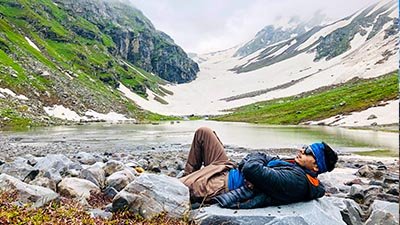
Hampta Pass Trek
It is a pass in the Himalayas of Himachal Pradesh connecting Kullu and Spiti valley

KASHMIR GREAT LAKES TREK
It is indeed one of the most beautiful treks in the country. Like it is said if there is heaven it is there.....

Tarsar Marsar Trek
The Tarsar Marsar Lake is an alpine lake located in Tral valley of Pulwama district in Jammu and Kashmir
